Hello Dear Readers,
Although the trees across my region are announcing that autumn is deepening, the weather is clinging to summer, and we have had some scorching days in the first month of autumn, with temperatures reaching 35 degrees C with unusually hot nights. While I do love summer’s Dog Days, autumn is my favourite season and I am missing the cold, crisp air, and misty mornings that usually temper the fiery autumnal colours. At least this warm weather gives my vegetables a chance to grow and ripen despite planting them very late in the growing season. My dahlias are also pumping out gorgeous flowers, despite my amateur first attempts. I hope I can get at least one carving pumpkin to size for Samhain but a sudden turn in the weather might scuttle the entire crop. Such is life, the gamble that many farmers and growers know only too well.
The blackberry and raspberry harvests have long passed, and many berries have desiccated on the brambles with the unseasonal heat and dryness. Although the hawthorn and apple trees are heaving with their bounty. Despite the heat, it was still lovely to greet the autumn equinox dawn last week, and then gather and forage haw berries, rose hips and acorn-decked oak branchlets for my seasonal display. I’m sure our house elf, Poppa, enjoyed his celebratory drink of mead and bowl of seasonal snacks.


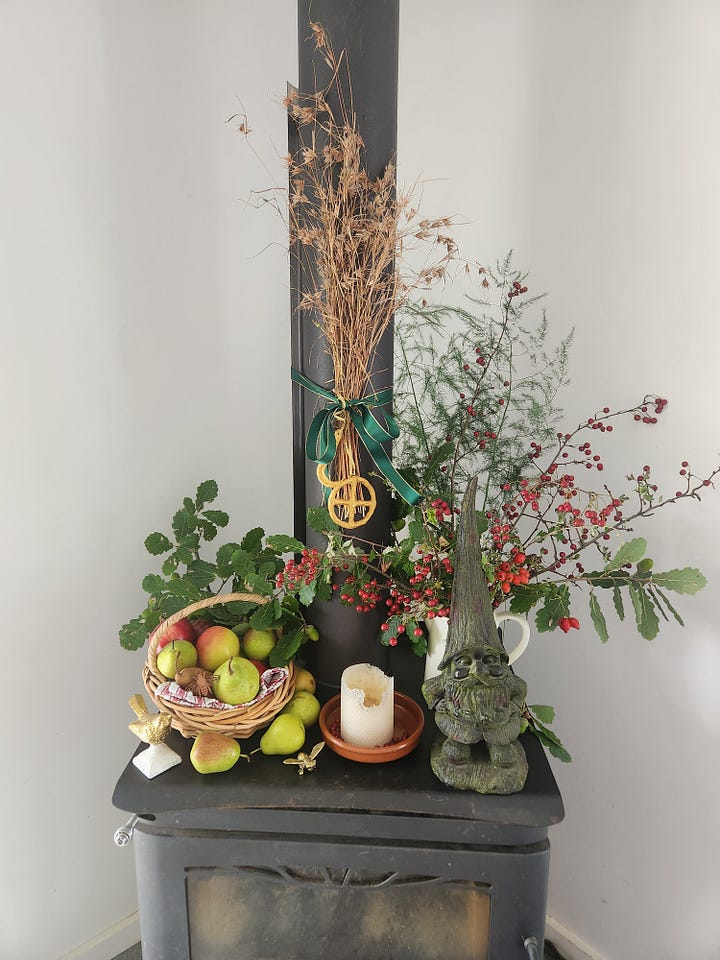
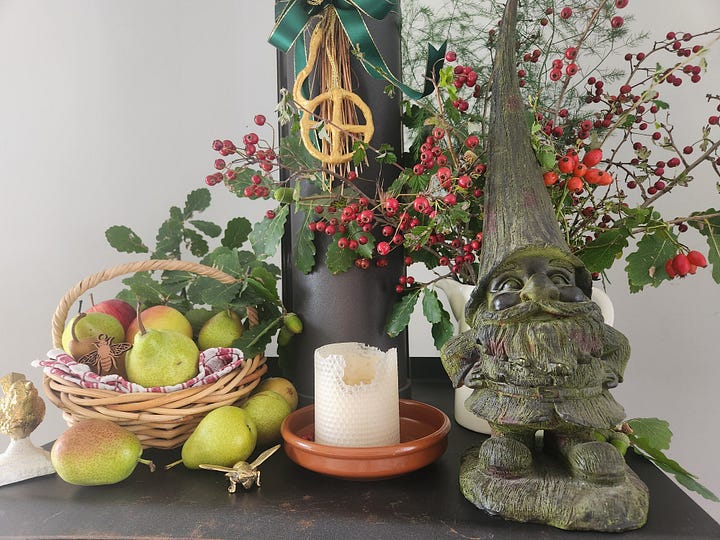
Later this month, many Christians will celebrate Easter, along with secular traditions. My son’s school, along with many other schools, are holding their annual Easter Hat Parade before the school holidays. Long-time readers will know that for me, celebrating (secular) Easter at this time of year comes with a large scraping of seasonal dissonance. It is difficult to resonate with stores, households and tables being decorated with the symbols, icons and colours of spring, in the midst of our autumn. Although I enjoy the chocolate hunt as much as my children, as well as the excitement of a visit from the Easter Bunny, I have been rebelling against this seasonal dislocation for a while. I prefer to buy chocolate bilbies instead of bunnies and chocolate bugs, frogs or fish instead of eggs if I can find them.
Last year my rebellion was a bit more public with the creation of an autumn-themed rather than spring-themed hat for my youngest son’s first Easter Hat Parade at school. It felt good to share the magic of autumn with my youngest and foster his appreciation for the season. This year, I have started working on a Baba Yaga-themed hat, to both my own and my son’s excitement. We love Baba Yaga, and I think her house on chicken legs is working out well. I will share photos of the finished hat next week, in time for the school Easter Hat Parade.
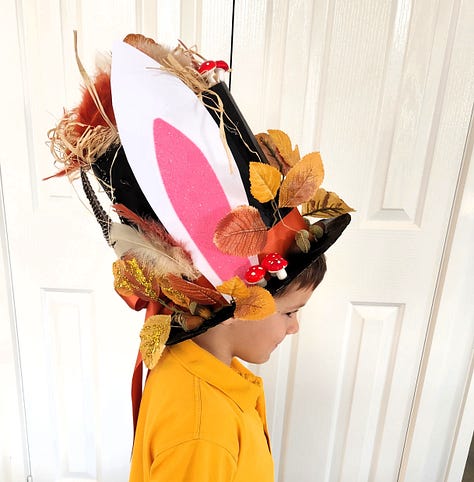
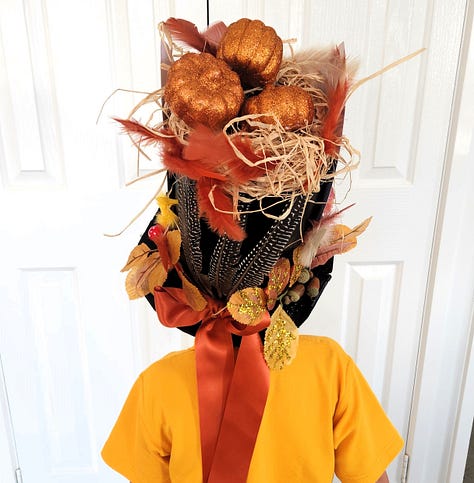
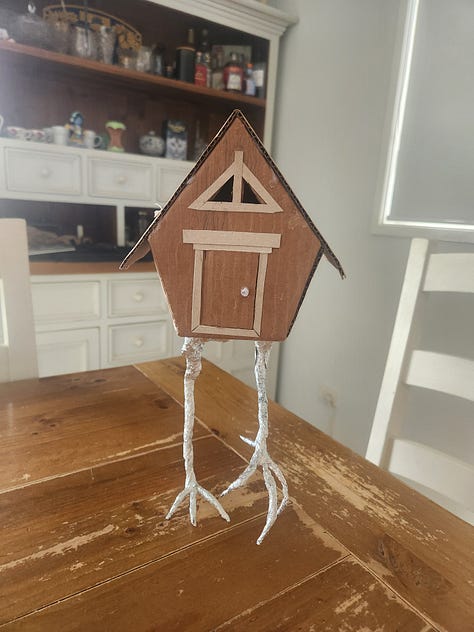
If anyone is interested in Easter symbology, especially Easter eggs and bunnies, you are welcome to listen to or read the Easter-themed episodes below:
This week, in honour of April Fools Day, we will explore its history and the different traditions that mark this day of shenanigans and tricks. Last year, April Fool Day’s fell on Easter Monday, a time when people with Polish and other Eastern European backgrounds celebrate another fun tradition, Śmigus Dyngus. To boost April’s fun and tricksy theme we’ll also dive into the water-filled history and traditions of Śmigus Dyngus. Enjoy!
April Fools
April Fools' Day, celebrated on April 1st, is a day dedicated to lighthearted pranks across the Western world. Its origins, however, remain a mystery.
The most widely accepted theory traces April Fools' Day back to 1582 when France transitioned from the Julian calendar to the Gregorian calendar. Those who failed to realise that the start of the new year had shifted to January 1st and continued to celebrate it during the end of March became the targets of jokes and pranks. Another theory for the origin of April Fool’s Day points to the ancient Roman festival of Hilaria, celebrated at the end of March, where people would dress up in disguises and mock one another.
In England and its former British colonies, April Fool’s Day is only celebrated for half a day. Pranks and jokes are only permitted until the clock strikes noon and anyone playing a joke or prank after midday is considered a real April fool. In Scotland, the tradition evolved into a two-day event. The first day is called Gowkie Day, with the gowk, or cuckoo, being a symbol of the fool. Pranks often involve sending people on phony errands, called Hunting the Gowk. The second day is known as Tailie Day, when people attach fake tails or "kick me" signs to unsuspecting individuals.
In Portugal, the day is called Dia das Mentiras or Day of Lies. In France, Belgium, Italy and French-speaking areas of Switzerland, April Fools’ Day traditions most often involve sticking a paper fish on someone’s back without them noticing. It is called April Fish, or Poisson d’Avril in French and Pesce d’Aprile in Italian.
In the Netherlands, it is apparently quite common to catapult or slingshot a herring at neighbours and yell “haringgek” (herring fool). Germans like to fool others by telling made-up, often outrageous, but harmless stories called Aprilscherz. In Greece, pranksters are said to gain good luck for the entire year if their pranks are successful.
Spain doesn’t celebrate April Fool’s Day but it does have a similarly lighthearted tradition called Día de los Inocentes (Day of the Holy Innocents), celebrated during the Christmas season on 28 December. During Día de los Inocentes it is customary to play light-hearted pranks and practical jokes. A popular custom involves taping a paper-doll cutout called monigote on the back of unsuspecting friends, colleagues or passers-by. Those who are tricked are called inocentada (innocents) and when the prank is revealed, the pranksters shout “Inocentada!”


In more recent times, media outlets and well-known brands often participate in April Fools' Day pranks by broadcasting outlandish stories to trick their audiences or customers. One of the earliest April Fools pranks in the media occurred in 1749. A London newspaper advertised an extraordinary event where a man planned to contort himself into a wine bottle and serenade the audience from within, among other astonishing feats. Legend has it that two individuals made a wager on whether people would attend to witness the seemingly impossible spectacle. The result exceeded expectations, with the venue packed to capacity. However, to the dismay of the attendees, no performer materialized on stage. Feeling deceived, the audience erupted into a riot.
However, the Great Spaghetti Harvest Hoax remains one of the most famous April Fools' Day pranks of all time. Orchestrated by the globally respected and (usually) serious BBC in 1957, it featured a family in Switzerland harvesting spaghetti from trees, exploiting the public's unfamiliarity with the food, which was not widely eaten in the UK at the time. The hoax was so successful that many viewers contacted the BBC for advice on growing their own spaghetti trees. Please do yourself a favour and watch the short (2:26 mins) BBC documentary below, it’s so well done!
The BBC also unknowingly participated in an April Fools’ prank in 1976, when their radio network reported on British astronomer Patrick Moore’s Jovian-Plutonian Gravitational Effect. Moore claimed that at 9:47 am on April 1 an alignment of Jupiter and Pluto would temporarily reduce Earth's gravity, allowing people to feel a floating sensation if they jumped at the exact right moment. The hoax was successful, with many people calling into the BBC to report they felt the effects.
The short (2:35mins) video below provides a quick and colourful potted history of April Fool’s Day.
Last year, April Fools Day happened to fall on Easter Monday, also known as Śmigus-Dyngus, Wet Monday or Dyngus Day among the Polish diaspora.
Śmigus Dyngus
Śmigus-Dyngus is a Polish tradition celebrated on the Monday and Tuesday following Easter Sunday. Also known as Dyngus Day, it involves the playful custom of dousing others with water, often using buckets, plastic bottles and water guns or even dunking people in rivers, ponds and cold baths. People of all ages participate in light-hearted water fights, symbolically washing away the sorrows and hardships of the past year and welcoming the arrival of spring with renewed energy and vitality. Men traditionally drenched women on the Monday, and women did the same to men on the Tuesday.
Many scholars believe the custom of Śmigus-Dyngus has pre-Christian roots related to the Spring Equinox and water’s symbolism of rebirth, renewal and fertility. Drenching people with water (traditionally newly thawed water) also symbolised cleansing away dirt and diseases. For Christians, water drenching symbolises the cleansing of the year’s sins and the ritual of baptism. This custom is also an ancient form of courtship, with young men often targeting young women they are interested in with water as a playful way to express affection. However, it also has the potential to cause trauma for unwilling victims.
An accompanying custom that has (thankfully) fallen out of fashion involves whipping each other’s legs with pussy-willow, birch or even juniper branches. Both the water drenching and pussy-willow whipping could be stopped with the exchange of a decorated Easter egg called pisanki.
The name Śmigus Dyngus is derived from two Polish words: śmigus, meaning to splash or pour water, and dyngus, which refers to the act of shaking or striking. Historically, the tradition was practised mainly in Poland, but it has spread to other Slavic countries and regions with significant Polish communities, such as Ukraine, Slovakia, and parts of the Czech Republic.
In modern times, Śmigus Dyngus has become a popular and widely anticipated tradition in the Polish diaspora, with organised events and festivals featuring traditional music, dancing and food, as well as communal water fights. The video (2:05 mins) below shows footage of Śmigus-Dyngus celebrations in the small Southern Polish town of Wilamowice.
I hope you enjoyed this fun-filled exploration of April Fool’s Day and Śmigus Dyngus. Next week we begin our final series of episodes for this seasonal year, by exploring the spooky season of Samhain, the root of our modern Halloween. Until then may you all enjoy some April Fish but please avoid flying herrings!
See you next week for Episode 37 - Samhain: Bonfires, Divination and the Ancestors.






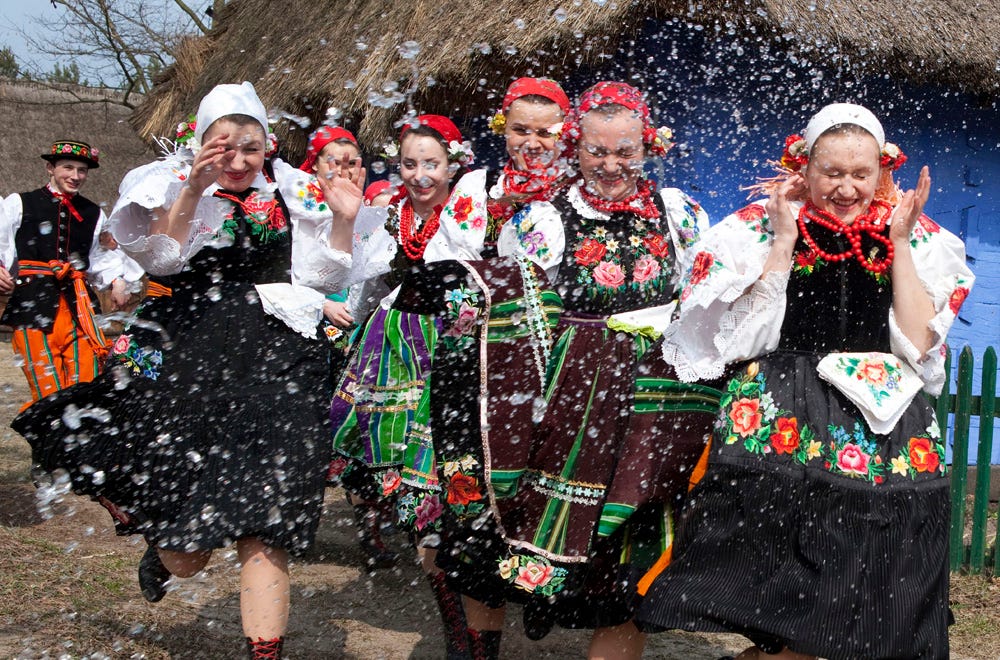








Share this post